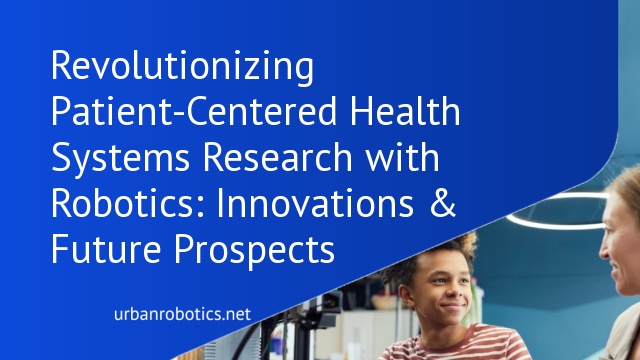Understanding Patient-centered Health Systems Research
Patient-centered health systems research aims to tailor healthcare to meet individual patient needs, preferences, and values. We explore this by focusing on several key areas:
- Patient Engagement: Involving patients in decision-making processes enhances their satisfaction and outcomes. Patients contribute valuable insights, helping healthcare providers deliver more personalized care.
- Health Outcomes Tracking: Tracking and analyzing health outcomes provides actionable data to improve patient care. This process helps identify effective treatments and flag areas needing improvement.
- Innovative Technologies: Utilizing cutting-edge technologies like robotics assists in delivering customized care. Robots support healthcare staff by performing routine tasks, allowing professionals to concentrate on more complex patient needs.
- Data-Driven Insights: Collecting and analyzing patient data enhances our understanding of effective practices. This insight allows us to refine protocols and offer care that aligns with patient expectations and medical standards.
By integrating patient engagement, health outcomes tracking, innovative technologies, and data-driven insights, we can improve patient-centered care. This comprehensive approach ensures healthcare systems become more adaptive, efficient, and aligned with what matters most to patients.
The Role of Robotics in Healthcare
Robotics plays a crucial role in advancing healthcare by enhancing patient-centered approaches. This involves integrating technology to improve patient outcomes and streamline clinical workflows.
Key Applications of Robotics
Robots assist in various healthcare settings, improving efficiency and patient care. Surgical robots, like the da Vinci Surgical System, enhance precision in minimally invasive procedures. Rehabilitation robots, such as exoskeletons, aid in patient recovery by providing tailored physical therapy. Additionally, robotic assistants in hospitals automate tasks like medication delivery and sanitation, reducing human error and infection risk.
Advantages of Robotics in Healthcare Settings
Robotic systems offer significant benefits, enhancing precision and efficiency in medical procedures. Surgical robots reduce recovery time and surgical complications, contributing to better patient outcomes. Automation in hospitals, including pharmacy robots, streamlines operations and ensures accurate medication dispensing. Robotic-assisted rehabilitation improves therapy outcomes through personalized treatment, accelerating patient recovery and increasing overall satisfaction.
Integrating Robotics into Patient-centered Treatments
Robotics offer transformative potential in patient-centered treatments by enhancing the patient care experience and clinical outcomes.
Enhancing Patient Experience
Robotic systems streamline patient interactions and treatment processes. Robots assist with routine tasks like taking vital signs, enabling healthcare workers to focus more on direct patient care. Robotic companions reduce loneliness among long-term hospital patients, offering emotional support and consistent interaction. Furthermore, assistive robots improve mobility for disabled or elderly individuals, enabling them to lead more independent lives. This integration of robotics fosters a more personalized, attentive healthcare environment, amplifying patient satisfaction.
Improving Clinical Outcomes
Advanced robotics significantly boost clinical outcomes by increasing treatment precision and reducing human error. Surgical robots execute minimally invasive procedures with high accuracy, resulting in faster recovery times and fewer complications. In rehabilitation, adaptive robots tailor therapy sessions to individual patient needs, ensuring optimal rehabilitation progress. Data collected by diagnostic robots enhances disease monitoring and early detection, subsequently enabling timely and accurate treatments. This precise and efficient approach underpins improved clinical results and aligns perfectly with patient-centered care principles.
Challenges and Barriers
Technical Challenges
Integrating robotics into patient-centered health systems brings significant technical challenges. Robots require advanced hardware and software; maintenance and updates also complicate deployments. Network infrastructure must support real-time data processing, crucial for robotic precision and responsiveness. High initial costs and the need for specialized training for healthcare professionals can hinder widespread adoption. Moreover, ensuring interoperability between various robotic and existing healthcare systems remains a persistent challenge, resulting in potential delays and inefficiencies in patient care.
Ethical Considerations
Ethical considerations pose substantial challenges in robotics integration within healthcare. Patient privacy concerns arise due to the extensive data collection and real-time monitoring by robots. Informed consent must be obtained when involving robots in patient care, ensuring transparency. Balancing the robotic assistance with human empathy remains critical, as over-reliance on robots could diminish patient-clinician relationships. Additionally, there are concerns about data security, the potential for hacking, and the misuse of sensitive health information. Addressing these ethical issues ensures that robotics enhances rather than undermines patient-centered care principles.
Future Prospects of Robotics in Patient-centered Care
Robotics is poised to revolutionize patient-centered care, addressing both current challenges and future needs.
Emerging Trends
Wearable robotics and exoskeletons are gaining traction. These devices, designed to assist with mobility and rehabilitation, offer customized therapy. Telepresence robots are being deployed to enable remote consultations, allowing patients and healthcare providers to connect efficiently. AI-driven robots are streamlining administrative tasks, improving workflow, and freeing up human resources for direct patient care.
Innovations on the Horizon
Personalized robotic companions are emerging, providing emotional support and monitoring health metrics. Surgical robots are advancing with enhanced precision, benefiting procedures across disciplines. Rehabilitation robots are incorporating machine learning to adapt to individual patient progress, optimizing recovery plans. 3D bioprinting robots are being developed to create patient-specific tissues and organs, which could transform transplant medicine.
Conclusion
The integration of robotics in patient-centered health systems research is transforming healthcare. By focusing on patient engagement and tracking health outcomes, robotics is enhancing clinical processes and delivering tailored care. While challenges like technical obstacles and ethical concerns remain, the future looks promising with advancements in wearable robotics, telepresence robots, and AI-driven administrative tools.
Emerging innovations such as personalized robotic companions and 3D bioprinting robots are set to revolutionize patient care. As we navigate these advancements, it’s crucial to address the existing barriers to unlock the full potential of robotics in healthcare.





